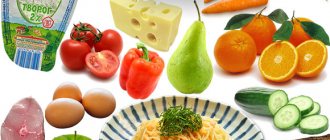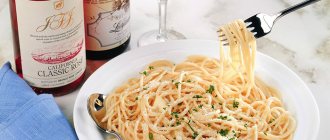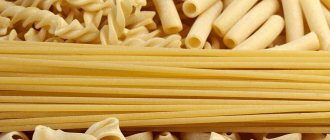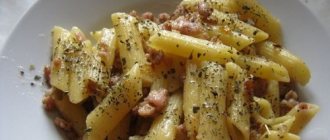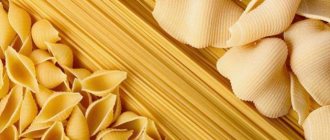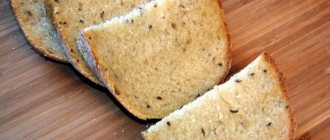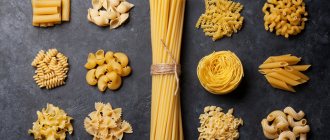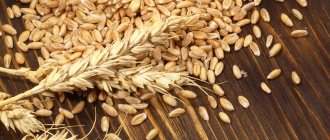In the modern world, pasta is the most popular product and is in great demand among the population. Today there are several types of this product. Thanks to pasta, we can always prepare incredibly tasty noodles stuffed with meat or fish, juicy cannelloni, spaghetti and much more. Their calorie content directly depends on the raw materials and method of preparation.
Today we will look at the energy value of this product, find out how many carbohydrates and proteins are in pasta. We will also study the varieties of these products. In addition, you will learn the beneficial properties and composition of pasta. At the end of the article you will find a small surprise - several simple and interesting recipes with pasta.
How much protein is in pasta
Pasta is one of the traditionally favorite food products for Russians. There is a special attitude towards them - if in the culinary traditions of other nations they act primarily as a side dish, in Russia it is often the main dish. It's quick to prepare, inexpensive, and incredibly delicious. And it’s also useful.
Beneficial features
From a health point of view, the main characteristic of pasta is its high level of protein .
Protein is of enormous importance for our body. With its deficiency in the diet, a person experiences the formation of excess fat mass with a simultaneous decrease in muscle mass, as well as a weakening of the immune system. Therefore, in some cases, nutritionists recommend that people eat more pasta. However, it should be taken into account that the final properties are determined by the composition of pasta, as well as production technology . This also applies to protein levels. Some species are characterized by high levels of protein, others are depleted in it. Specific information about how much protein is in pasta , according to the rules, must be placed on the packaging. Experts recommend paying close attention to this information.
Composition of pasta
Today the range of pasta is incredibly diverse. The names are simply dazzling. At the same time, the protein concentration per 100 grams in different products varies greatly, which is explained by the quality of the raw materials used and the methods of its processing.
Therefore, those who are concerned about the question of how much protein is in the pasta they eat should pay attention to the composition. Preference should be given to pasta made from durum wheat flour. They have a high gluten content, which is the main source of protein. To put it simply, the healthiest pasta is the one that does not become overcooked or soggy even after being in soup or other liquid dishes for a long time.
But the presence of refined wheat flour and specially processed semolina in the composition negatively affects the protein content. The dough uses almost no yeast or grain germs. The amount of fiber in “white” pasta tends to zero, which also negatively affects its usefulness and protein level.
Thus, if we consider the issue from this side, then the palm belongs to coarsely ground products. They are characterized by a higher protein content, the source of which is bran and germ. But products of the highest category, on the contrary, contain a very small amount of protein per hundred grams.
Types of pasta and protein content in them
Modern pasta can be divided into several types. They differ in composition, which directly affects how much protein is in the pasta . The classification of pasta looks like this:
- egg noodles are made from flour, water and eggs, so the protein content in it is much higher than in those varieties for which egg powder is used;
- pasta made from corn flour, which is poor in proteins compared to wheat. In such products the protein content is much lower, but they are more easily absorbed by our body. What is more preferable is for everyone to decide for themselves;
- complex pasta, for the production of which several different types of flour are used. Such products usually include additional components, for example, soy flour or quinoa, which enrich the product with protein;
- spelled wheat vermicelli. They add rye, which is very rich in protein and fiber;
- flavored pasta products that contain vegetable concentrates to enhance the taste. This composition has a positive effect on the nutritional value of the product, but its protein content is lower than in traditional varieties.
Another type of pasta, rare in Russia, is couscous - something between classic pasta and cereal . The raw material for making couscous is boiled and then dried semolina. Before this, it goes through several stages of purification and processing, due to which it loses a significant part of the protein.
Protein content by different manufacturers
How much protein is in pasta depends on where exactly and by whom it was produced. For example, products from Italy are characterized by the highest level of protein, the concentration of which is 12-14 grams per 100 grams of the finished product. It is clear that Italians have a special relationship with pasta, which is their number one product, hence the quality of the products. The products of leading Russian companies contain no more than 11 g of protein per 100 g of finished pasta, but in this indicator they are ahead of many European manufacturers.
So, in terms of pasta, the domestic manufacturer did not lose face.
Features of durum wheat or durum. Comparison of hard and soft flour
Wheat has thousands of varieties, but among this diversity, 2 large groups stand out: soft and durum wheat.
Soft wheat varieties are primarily grown in climates with high humidity. Such wheat occupies a large part of the market. The main producers are located in Russia, Ukraine, Western Europe, Kazakhstan and the CIS, as well as in Australia.
Durum wheat varieties are grown where the climate is drier. In the USA, Argentina, countries of Asia, North Africa and some regions of Russia.

In Russia, durum wheat is mainly represented by spring varieties. This wheat needs approximately 100 warm days to fully ripen. The harvest is usually harvested when the grain moisture content reaches 13%.
Not every climate is suitable for growing durum wheat. Durum spring wheat is sown and harvested mainly:
- In the Trans-Urals. In the forest-steppe part of the Chelyabinsk and Kurgan regions;
- On South. In the Krasnodar region and Stavropol region.
- In the southeast. In the Volgograd, Saratov and Orenburg regions.
- In the Altai Territory and Omsk Region

According to the head of the information and analytical department of the Russian Grain Union, Sergei Shakhovets, there is no exact data on the amount of durum wheat. It is not customary to specifically identify and take into account such varieties. Such statistics are usually kept at the regional level. This is most likely due to the fact that durum wheat is grown to order from large processing enterprises that produce pasta.
Wheat varieties differ from each other in appearance.
Durum wheat is in many ways similar to soft wheat, but has its own characteristics.
Features of durum wheat:
- Long and dense ear.
- The grain is elongated, hard and small in size. Enclosed in a floral film to prevent excessive shedding.
- The grain color is the same. Brown or yellowish tint.
- Flour from such wheat absorbs liquid well and does not go stale for a long time.
The best semolina and pasta are obtained from such wheat.
Representatives are, for example, the spring durum wheat varieties Lilek and Nikolasha, bred by the Research Institute of Agriculture of the South-East.

Features of soft wheat varieties:
- The ear has thin walls and more empty space in the culm.
- The grains are larger and softer.
- The color of the grain can be white, yellow, burgundy.
- Flour from such wheat absorbs liquid less well and is subject to rapid hardening.
Flour from such wheat is mainly used for making bakery and confectionery products.
Representatives are, for example, the varieties of winter soft wheat Guberniya and Kalach 60, bred by the Research Institute of Agriculture of the South-East.

If you “look inside,” the structure of soft and durum wheat is also different.
In hard pasta, the starch has a crystalline structure, while in soft pasta it is viscous. So, when cooking the latter, a large amount of dry matter and starch enters the water, which makes the water cloudy.
The current GOST allows no more than 6% of dry substances that pass into water.
Leading expert of the Institute of Agricultural Market Studies (IKAR) Igor Pavensky believes that grain production is directly proportional to the consumption of their processed products. And the amount of durum wheat that was grown in Russia can be calculated using data on the production of durum flour. To do this, you need to use in your calculations the conversion factor of produced flour into grain, which is approximately equal to 1000 kg of flour from 1330 kg of grain.
How many calories and carbohydrates are in pasta?
In the modern world, pasta is the most popular product and is in great demand among the population. Today there are several types of this product. Thanks to pasta, we can always prepare incredibly tasty noodles stuffed with meat or fish, juicy cannelloni, spaghetti and much more. Their calorie content directly depends on the raw materials and method of preparation.
Today we will look at the energy value of this product, find out how many carbohydrates and proteins are in pasta. We will also study the varieties of these products. In addition, you will learn the beneficial properties and composition of pasta. At the end of the article you will find a small surprise - several simple and interesting recipes with pasta.
Navy pasta, preparation and nutritional value
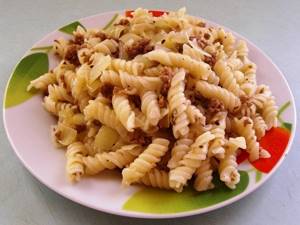
The calorie content of navy-style pasta directly depends on the type of minced meat used in preparation.
Minced pork with a high fat content gives the dish more calories.
To significantly reduce the number of calories in this tasty dish, you can use minced meat from lean meats: veal, chicken, lean beef, for example, the calorie content of pasta with chicken will be 300 kcal, and with minced meat it is already 234 kcal per 100 grams.
Oil can also be almost completely excluded from the cooking ingredients.
In this case, the minced meat can be stewed in a frying pan with a minimum amount of regular or filtered water and 1 spoon of oil.
Product Description

What is pasta? These are products made in various forms, in most cases from wheat flour. The dough is kneaded using purified drinking water and then dried using special technologies. In some cases, manufacturers use rice or buckwheat flour. Many of us have seen colorful pasta on supermarket shelves. To obtain such a product, tomato paste, spinach or eggs are often added. The properties of such products directly depend on the type and quality of the ingredients used.
How many grams of carbohydrates are in 100 grams of pasta? It all depends on their variety, composition and preparation method. In this article we will return to this issue, but a little later.
In accordance with established GOST standards, products are divided into several categories:
- group A - pasta made from durum wheat flour of the first and second grades;
- group B - pasta from soft glassy wheat of the highest and first grades;
- group B - pasta products made from premium and first grade wheat baking flour.
Durum pasta contains slightly more gluten and less starch. But soft varieties include significantly more starch and less gluten. Proper and high-quality pasta contains virtually no fat or its amount is quite low.
Another type of this product is whole grain pasta, which is made from whole grains. The composition is striking in its high content of nutrients and minerals with such a low calorie content. However, before moving on to the carbohydrate content of pasta, we will look at its beneficial properties.
Benefits and harms of products
The main positive qualities of pasta include the following factors:
- fiber, which is part of the product, is easily absorbed by our body, gives strength and retains protein;
- the fat in pasta is unsaturated, so it breaks down easily and makes our skin firmer, healthier and more elastic;
- quick saturation of the body;
- pasta is good for digestion and the cardiovascular system, thanks to its fiber;
- the same fiber allows you to easily and quickly remove all waste and toxins from the human body;
- contains B vitamins, phosphorus, calcium, potassium, iron and so on.
So how many carbs are in cooked pasta? It all depends on the variety, but the average value ranges from 40 to 60 grams.
Do not forget that excessive consumption of pasta can lead to excess weight gain. In this case, it is best to use whole grain pasta. This is due to the high content of nutrients and minerals, low calorie content and a brighter taste. But the price for such products will be much higher.
Calorie content and nutritional value of Pasta
Pasta is made from flour and water. Depending on what kind of flour was used to make them, certain properties of the product are distinguished, including the calorie content of pasta.
Until recently, only pasta made from soft flour was common in the post-Soviet space. The calorie content of boiled pasta of this type is about 350 kcal per 100 g.
In addition, they have a high glycemic index, that is, when eaten, sharp jumps in blood glucose and insulin are observed, which leads to increased appetite and the development of various chronic diseases.
Plant fiber in such pasta is a natural adsorbent, helps remove excess amounts of harmful substances and fats from the body, is a nutrient for valuable intestinal bacteria, and promotes normal digestion.
Pasta made from durum wheat contains a large amount of vitamins B and E, minerals (iron, potassium, manganese, phosphorus) and other trace elements. In addition, the composition of proteins and carbohydrates allows them to be recommended in baby food.
The calorie content of durum pasta is 213 kcal per 100 g.
It should also be noted that as part of a healthy diet, you should consume pasta made exclusively from flour and water. If we are talking about colored pasta, you need to make sure that the food colors are of natural origin (beet juice, carrots, spinach, etc.).
Spaghetti is the most famous and popular Italian pasta. Despite the fairly high calorie content of spaghetti - 345 kcal per 100 g, they, as a rule, do not contribute to the appearance of excess body weight, since they do not contain fat. Of course, this rule works in cases where the dish is prepared based on the manufacturer’s recommendations and does not exceed the cooking time set by him.
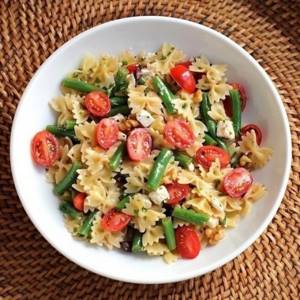
Of course, we can’t help but mention the navy-style pasta that we all love since childhood. The calorie content of Navy pasta is approximately 360 kcal. Obviously, this dish cannot be called dietary, but it is sometimes acceptable to include it in the diet of people watching their own weight, subject to a number of rules.
To optimize the calorie content of navy-style pasta, you should take pasta made from durum wheat. It is better to prepare minced meat from boiled chicken breast, turkey or veal with the addition of a sufficient amount of onion.
It is better to fry the minced meat in a ceramic-coated frying pan with a small amount of olive oil.
The finished dish is seasoned with black and red hot peppers, which promote weight loss, and generously sprinkled with chopped parsley; served with vegetables.
For a very long time, pasta has been used as one of the types of side dishes for any dish (meat, fish, vegetables).
This product has never been in short supply, which is most likely why people are accustomed to using it quite often.
This is logical: affordable, nutritious and varied products are always at hand, they do not require any high level of cooking and can always be supplemented with something.
But due to the increased interest of society in healthy and so-called proper nutrition, the demand for ordinary products has dropped slightly, everyone is now actively looking for pasta that will bring benefits. Let's figure out how to choose pasta wisely
Types of pasta
Pasta is a dough product, usually made from wheat flour with the addition of water. These are also slow carbohydrates that give you a feeling of fullness for several hours. But nutritionists and nutrition experts recommend consuming durum wheat pasta, as it contains more beneficial micro- and macroelements.
Interesting Facts
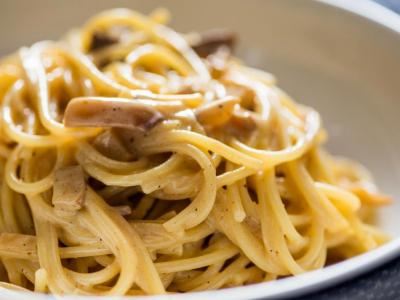
Before we get into how many carbohydrates are in pasta, we suggest you consider some interesting facts about this product.
So, a few facts about this product:
- 100 grams of raw pasta turns into a 250 gram serving;
- It’s best to stick to pasta made from durum wheat;
- the glycemic index of this product is 50. But if they are slightly undercooked, the index is reduced to 40;
- ideal pasta has a golden hue with an admixture of amber color;
- the structure of a quality product is quite dense, but at the same time flexible;
- When cooking good pasta, the water does not change its color, and the product itself does not boil, deform or stick together.
Italian film actress Sophia Loren, known for her slim figure and beauty, tells the public that she loves and constantly cooks pasta with various fillings. “I owe everything I have to spaghetti,” says the public figure.
Composition of fast carbohydrates
Simple carbohydrates, depending on their molecular structure, are divided into mono- and disaccharides. The chemical formula of monosaccharides from carbon dioxide and water is easily broken down. They have a sweet taste and are highly soluble in water. Monosaccharides include the following:
- The most common glucose. It is found in regular sugar and sweets, grapes, carrots, corn and berries. Its function is to provide the body with the energy necessary for brain activity, normal functioning of the liver and other organs, muscle endurance, and the absorption of fats and proteins in the cell. Lack of glucose affects fatigue and irritability. At extremely low levels, fainting is possible.
- Fructose, partially processed without the participation of insulin in the liver into glucose. Sources of fructose are honey, ripe sweet fruits and berries: melon, cherries, apples, black currants.
- Galactose is a breakdown product of lactose during the breakdown of dairy products in the stomach. It is also converted into glucose in the liver.
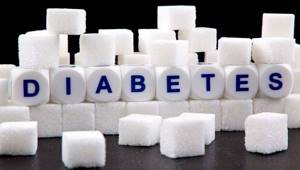
Disaccharides consist of two molecules.
- Sucrose – beet, cane and brown sugar, molasses.
- Lactose is the only carbohydrate of animal origin found in milk. It is absorbed only if there is a sufficient amount of the lactase enzyme. In 40% of the adult population, the function of lactose absorption is impaired due to lactase deficiency, resulting in irritation of the digestive tract: heartburn and increased gas formation. In this case, fermented milk products, in which lactase has turned into lactic acid, come to the rescue.
- Maltose is formed as a result of fermentation of grapes, during the formation of malt. Present in beer, molasses, honey and oranges.
- Mannose is a safe carbohydrate that does not affect metabolism.
How many grams of carbohydrates are in pasta?
Now that we have learned about the beneficial properties and categories of the product, we can move on to its nutritional value.
Dry pasta contains:
- proteins - 10.4 grams;
- fats - 1.1 grams;
- carbohydrates - 64.5 grams;
- calories - 327 kcal.
How many carbohydrates are in boiled durum pasta:
- proteins - 3.5 grams;
- fats - 0.4 grams;
- carbohydrates - 23.2 grams;
- calories - 112.
However, do not forget that if you add butter or various sauces to pasta, the calorie content increases to 170 kcal. But everyone’s favorite dish, navy-style pasta, has about 230 kcal. Therefore, they should not be abused by those losing weight.

Now you know how many carbohydrates are in solid pasta, what their energy value and benefits are. Knowing this data, you can easily adjust your own diet. Many people mistakenly believe that after eating a portion of pasta, they will immediately gain excess weight. But this is not so, because products made from durum wheat allow you to eat your favorite spaghetti or noodles, while remaining slim and healthy.
Calorie content and nutritional value of Pasta
Pasta is made from flour and water. Depending on what kind of flour was used to make them, certain properties of the product are distinguished, including the calorie content of pasta.
Until recently, only pasta made from soft flour was common in the post-Soviet space. The calorie content of boiled pasta of this type is about 350 kcal per 100 g.
In addition, they have a high glycemic index, that is, when eaten, sharp jumps in blood glucose and insulin are observed, which leads to increased appetite and the development of various chronic diseases.
Plant fiber in such pasta is a natural adsorbent, helps remove excess amounts of harmful substances and fats from the body, is a nutrient for valuable intestinal bacteria, and promotes normal digestion.
Pasta made from durum wheat contains a large amount of vitamins B and E, minerals (iron, potassium, manganese, phosphorus) and other trace elements. In addition, the composition of proteins and carbohydrates allows them to be recommended in baby food.
The calorie content of durum pasta is 213 kcal per 100 g.
It should also be noted that as part of a healthy diet, you should consume pasta made exclusively from flour and water. If we are talking about colored pasta, you need to make sure that the food colors are of natural origin (beet juice, carrots, spinach, etc.).
Spaghetti is the most famous and popular Italian pasta. Despite the fairly high calorie content of spaghetti - 345 kcal per 100 g, they, as a rule, do not contribute to the appearance of excess body weight, since they do not contain fat. Of course, this rule works in cases where the dish is prepared based on the manufacturer’s recommendations and does not exceed the cooking time set by him.
Of course, we can’t help but mention the navy-style pasta that we all love since childhood. The calorie content of Navy pasta is approximately 360 kcal. Obviously, this dish cannot be called dietary, but it is sometimes acceptable to include it in the diet of people watching their own weight, subject to a number of rules.
To optimize the calorie content of navy-style pasta, you should take pasta made from durum wheat. It is better to prepare minced meat from boiled chicken breast, turkey or veal with the addition of a sufficient amount of onion.
It is better to fry the minced meat in a ceramic-coated frying pan with a small amount of olive oil.
The finished dish is seasoned with black and red hot peppers, which promote weight loss, and generously sprinkled with chopped parsley; served with vegetables.
For a very long time, pasta has been used as one of the types of side dishes for any dish (meat, fish, vegetables).
This product has never been in short supply, which is most likely why people are accustomed to using it quite often.
This is logical: affordable, nutritious and varied products are always at hand, they do not require any high level of cooking and can always be supplemented with something.
But due to the increased interest of society in healthy and so-called proper nutrition, the demand for ordinary products has dropped slightly, everyone is now actively looking for pasta that will bring benefits. Let's figure out how to choose pasta wisely
Types of pasta
Pasta is a dough product, usually made from wheat flour with the addition of water. These are also slow carbohydrates that give you a feeling of fullness for several hours. But nutritionists and nutrition experts recommend consuming durum wheat pasta, as it contains more beneficial micro- and macroelements.
To date, the variety of products is very large, so it is worth being able to distinguish between them. They differ in shape, color, taste and cooking speed.
Long products (also called pasta):
- vermicelli;
- spaghetti;
- spaghettini;
- fettuccine;
- capellini, etc.
- farfalle (we call them “butterflies”);
- conchiglie (or “shells”);
- capeletti (similar to small Russian dumplings), etc.
All names of pasta are Italian, since, according to experts, it was in Italy that they became widespread. After all, over 200 pasta dishes are known there!
Our body benefits from consuming this product. And the most important ingredient in them is fiber, which helps the gastrointestinal tract function properly and cleanses the body of all kinds of toxins and undigested elements. Pasta is a high carbohydrate product.
Many (especially women) try to completely exclude them from their diet. But in vain, since these are slow carbohydrates that take longer to digest and do not affect blood sugar levels in any way. Moreover, athletes, people with high levels of physical activity, and even those on a diet are strongly recommended to use this type of product.
After cooking, the pasta does not lose its beneficial substances, macro- and microelements.
A little trick: when cooking pasta, try to undercook it a little. The result will be so-called “al dente”, as the Italians say. The benefits from them are greater and the feeling of fullness lasts longer.
Calorie content
Calorie content in its pure form (i.e., those products that have not been subjected to heat treatment) varies from 300 to 400 kcal per 100 grams. You can find the composition and KBJU (calories, proteins, fats, carbohydrates) on the product packaging itself.
When cooking, the calorie content does not change, but remember that calories are counted by the dry weight of the product, and not by the finished weight. That is, first you need to weigh a certain amount of pasta that you want to cook and “drive” it into your calorie counter. It is then that the figure will be correct, because when cooked, pasta tends to boil over and becomes heavier, which accordingly changes its weight.
The calorie content of pasta depends on its type and manufacturer. For example, buckwheat pasta will have about 370 kcal per 100 g, but regular, whole grain pasta can have either 333 kcal/100 g (Naturata pasta) or 360 kcal/100 g (JamieOliver).
Cooking the Italian way

Having figured out how many carbohydrates are in 100 grams. pasta, we can move on to the simplest and most delicious recipe.
So, the necessary products:
- tomatoes - 4 pcs;
- garlic cloves - 2 pcs;
- pasta - 200 grams;
- green peas - 200 grams;
- olives - 5 pcs;
- hard cheese - 50 grams;
- chicken egg - 1 pc;
- vegetable oil - 1 tbsp;
- basil - half a bunch;
- salt;
- ground black pepper.
If desired, tomatoes can be replaced with thick tomato paste.
Step by step process
Our actions are:
- Pour cold water into a small saucepan, place on medium heat and wait until it boils.
- Open the package of pasta and pour it into salted water.
- Cook according to the instructions on the package and drain in a colander.
- Pour boiling water over the tomatoes, carefully remove the skin and cut into small cubes.
- Blanch the green peas in salted water for about three minutes and pour into a colander.
- Wash the basil greens and chop them with a sharp knife.
- Peel the garlic cloves from the film and divide into small pieces.
- Grate the cheese on a medium grater.
- Grease a baking dish with vegetable oil and place pasta in it.
- Add tomatoes and peas, mix the resulting mass thoroughly.
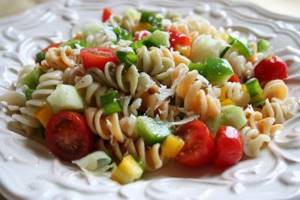
Before serving the finished dish, it must be garnished with chopped herbs and garlic. How many carbohydrates are in pasta? Approximately 62-65 in this dish per 100 grams.
Cooking method
What needs to be done:
- Following the instructions on the package, boil the pasta until tender and drain in a colander.
- Pour the required amount of cream into a saucepan and slightly heat the resulting mass.
- Grate the cheese and mix with cream.
- Add spices, salt and, if desired, some fresh herbs.
- Simmer over medium heat until the cheese begins to melt.
- Transfer the pasta to plates, pour in the sauce and serve.
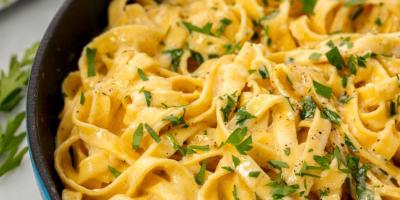
You can bake fish or chicken thighs with this dish.
Step-by-step preparation
Our next steps:
- Place a saucepan of cold water over medium heat and bring the liquid to a boil.
- Pour the pasta into boiling water, add a little salt and cook according to the instructions on the package.
- As soon as the pasta is ready, place it in a colander and allow time for excess liquid to drain.
- Pour hot water over the tomatoes, peel them and cut them into cubes about 1 cm thick.
- We pass the garlic cloves through a special press.
- Heat olive oil in a frying pan, add tomatoes and garlic.
- Simmer the resulting mixture for about three minutes.
- Now pour the green beans into the frying pan, cook for five minutes and pour in the tomato paste.
- Sprinkle all the ingredients with spices, mix and remove the pan from the heat.
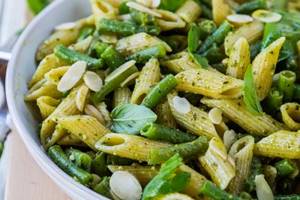
Transfer the pasta to plates and add green beans, tomatoes and garlic on top. For a brighter taste, you can add soy sauce. The amount of carbohydrates in pasta is about 60-40 grams.
Pasta examination: cones have a lot of protein and few violations
The consumer union Roskontrol has repeatedly tested pasta products. Among them are spaghetti, pasta, vermicelli, noodles of various brands. The turn has come to the horns, beloved by many consumers. How safe and high quality are they? Will they stick together when cooked? What kind of flour are they made from, are there any dyes or other unnecessary impurities in the composition? Experts answered these questions!
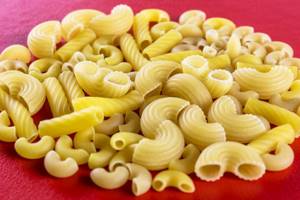
The consumer union Roskontrol sent seven samples of horns for examination. Pasta brands such as Rollton, Shebekinskie, Znatnye, Makfa, Extra M, Maltagliati, and Ameria have been tested for safety and quality.
Meets safety requirements. Made only from durum wheat. Do not contain residual quantities of pesticides. There are no signs of infestation or contamination by pests.
Meets safety requirements. Made only from durum wheat. Do not contain residual quantities of pesticides. There are no signs of infestation or contamination by pests. High protein content compared to average values for this type of product.
Meets safety requirements. Made only from durum wheat. Do not contain residual quantities of pesticides. There are no signs of infestation or contamination by pests. High protein content compared to average values for this type of product.
Good organoleptic characteristics. Meets safety requirements. Does not contain dyes, soy and corn flour.
Good organoleptic characteristics. Meets safety requirements. Does not contain dyes, soy and corn flour.
Good organoleptic characteristics. Meets safety requirements. Does not contain dyes, soy and corn flour.
Does not correspond to the “highest grade” group B pasta grade indicated on the label in terms of ash content. Good organoleptic characteristics. Meets safety requirements. Does not contain dyes, soy and corn flour.
Hard or soft?
For reference:
Durum wheat pasta is valued for being rich in protein, plant fiber and B vitamins, as well as potassium, magnesium, and phosphorus. They are a source of complex carbohydrates that provide us with energy, keep us feeling full for a long time and practically do not increase blood sugar levels.
All horns sent for examination are of the highest grade. Five samples belong to group A, two - "Extra M" and Ameria - to group B. What does this mean?
The “group A” label indicates that these pasta products are made from durum wheat. Group B – from soft wheat.
Visually, no specialist can distinguish what kind of wheat was used in the production of the product. This can only be done in the laboratory, using electrophoresis.
- Samples were tested for soft wheat contamination.
A small amount of soft wheat was found in the “Rollton” (about 8%) and “Znatnye” (about 12%) horns. GOST allows the presence of no more than 15% admixture of other types of wheat grains in durum wheat; flour for group A pasta can be made from such grain.
“Extra M” cones contain 24% soft wheat – these are group B cones, as indicated in the labeling.
The reader should know that in Europe this pasta would be considered counterfeit. European standards prohibit the use of soft wheat in pasta in principle.
- The samples were also tested for ash content. For pasta of group A of the highest grade, the mass fraction of ash should not exceed 0.9%, and for pasta of the highest grade of group B - no more than 0.56%.
In terms of ash content, all samples except “Extra M” correspond to the name, incl. the specified variety. “Extra M” pasta, the ash content corresponds only to the first grade.
In samples of pasta products of group A ( “Rollton” and “Znatnye” ) containing an admixture of soft wheat, a slightly lower ash content was noted than in products that do not have such an admixture.
- As for protein, for which wheat pasta is valued, all samples also meet the requirements. According to reference data, protein should not be less than 10.5%.
The most protein is in the Maltagliati (15%), the least in Ameria (12.5%).
Impurities, dyes and pests
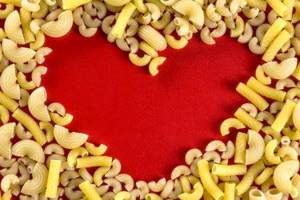
- Please note that all samples are made only from wheat flour. The examination did not reveal any impurities of either corn or soy flour.
Such impurities in pasta are unacceptable, but sometimes unscrupulous manufacturers allow themselves to “dilute” expensive wheat flour with cheaper substitutes.
- No dyes were found in the composition.
- No pest infestation or contamination was detected.
- The moisture content of the samples does not exceed the permissible values.
Get ready, horns, big and small!
For reference:
2 cooking modes are established by GOST ISO 7304. The standard provides for a cooking time “until ready” - this is the minimum cooking time plus 1 minute. And “overcooking” is the minimum cooking time plus 11 minutes.
Externally, the horns are impeccable. Yellow or light yellow, appropriate shape, without unpleasant taste and odor. What happens if you cook them?
Agree, it’s unpleasant to eat pasta that has stuck together into a shapeless lump. Therefore, the horns were welded at one of the stages of the examination. Cooking was carried out in two modes - “until ready” and “overcooking”. Not all pasta is resistant to longer cooking times. But such an indicator as “overcooking” most objectively shows the difference in the quality of pasta.
In both cases, all samples performed flawlessly. They didn't stick together or spread apart.
Has the quality of pasta improved?
How much are?
“Extra M” - 23.67 rub. Ameria - 26.99 rub. “Noble” - 39.90 rub. "Makfa" - 45.38 rub. “Rollton” - 45.99 rub. “Shebekinskie” - 51.99 rub. Maltagliati - 75.33 rub.
*price of horn samples at the time of purchase.
So, all samples are safe.
- Six samples of horns out of seven tested are of high quality and recommended for purchase.
- “Extra M” cones does not correspond to the highest grade.
Classification of carbohydrates
The simplest classification of carbohydrates
Monosaccharides
Monosaccharides are called simple sugars; they are the most basic unit of carbohydrates. They are the fundamental units of carbohydrates and cannot be hydrolyzed into simpler compounds.
Monosaccharides are the simplest form of sugar and are usually colorless, soluble in water, and crystalline solids; some of them have a sweet aroma. Examples of some common monosaccharides include fructose, glucose and galactose.
Monosaccharides are the basis on which disaccharides and polysaccharides are built. Some sources of this type of carbohydrate include fruits, nuts, vegetables and sweets.
Glucose
This is a simple sugar that circulates in the blood of animals. It is created during photosynthesis of water and carbon dioxide, using energy from sunlight. It is the most important source of energy for cellular respiration.
It is found in sugar from grapes and dextrose
Fructose
Also called levulose, it is a simple monosaccharide found in many plants, where it is often combined with glucose to form the disaccharide sucrose.
It is absorbed directly into the bloodstream during digestion. Pure and dry fructose is quite sweet, white, crystalline and odorless. It is the most soluble of all sugars.
Fructose is found in honey, flowers, most tubers and berries.
Disaccharides
This type of carbohydrate is formed when two monosaccharides are linked by a glycosidic bond. Like monosaccharides, they are also soluble in water.
The joining of simple sugar molecules occurs in a condensation reaction, which involves the removal of a water molecule from the functional groups. Along with other reactions, they are vital for metabolism.
Common examples include sucrose, lactose and maltose. The most common examples have 12 carbon atoms. The difference in these disaccharides is the atomic position within the molecule.
Sucrose
It is a natural and common carbohydrate found in many plants and plant parts. Sucrose is often extracted from sugar cane and sugar beets for human consumption.
The refining process of modern industrial sugar often involves the crystallization of this compound, often called granulated sugar or simply sugar.
This compound plays a central role as an additive in food production and human consumption throughout the world.
Lactose
It is a disaccharide consisting of galactose and glucose found in milk. Lactose makes up about 2-8% of milk, although it can be extracted from it.
Oligosaccharides
It is a saccharide polymer that contains small amounts of simple sugars. Oligosaccharides can have many functions, including recognizing and connecting cells. For example, glycolipids play an important role in the immune response.
Glycolipids
These are lipids with glycosidic-linked carbohydrates. Its main role is to maintain membrane stability and facilitate cell recognition.
Carbohydrates are found on the surface of the entire eukaryotic cell membrane.
Polysaccharides
These are polymeric carbohydrate molecules consisting of large chains of monosaccharide units linked by glycosidic bonds.
They have a wide structural spectrum, from linear to highly expanded. Examples include storage polysaccharides such as glycogen and starch, or structural polysaccharides such as cellulose.
Polysaccharides can be found in tubers, cereals, meat, fish, grains and vegetable leaves.
Glycogen
It is a multi-chain glucose polysaccharide that serves as a form of energy storage in humans, animals, fungi and bacteria.
The polysaccharide structure is the largest storage form of glucose in the body. In humans, glycogen is stored primarily in liver and muscle cells, hydrated with 3-4 parts water.
Glycogen functions as secondary energy storage in the long term, storing primary energy sources in adipose tissue.
Muscle glycogen is converted to glucose by muscle cells, and glycogen from the liver is converted to glucose so that it can be used throughout the body, including the central nervous system.
Cellulose
It is an organic compound consisting of a linear chain of several hundred or thousands of linked glucose units. Cellulose is an important structural component of the primary cell wall of green plants, as are many types of algae.
Some types of bacteria secrete it to form biofilm. Cellulose is the most abundant organic polymer on planet Earth.
Mainly used for paper production. Smaller amounts are converted into a number of by-products such as cellophane.



